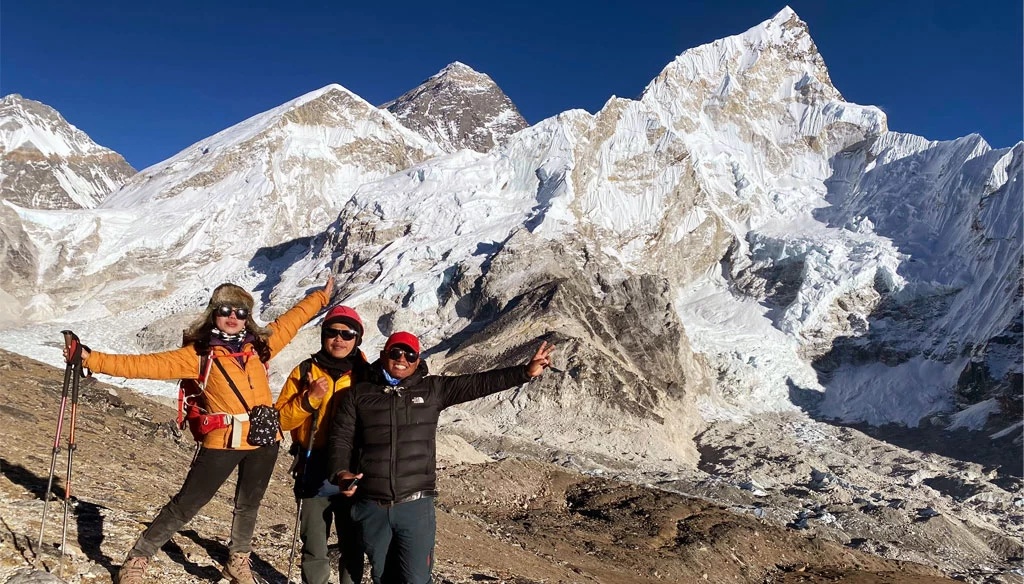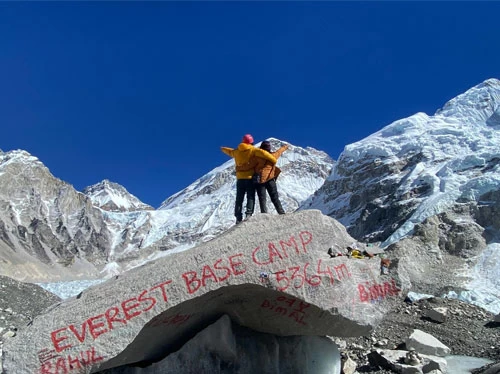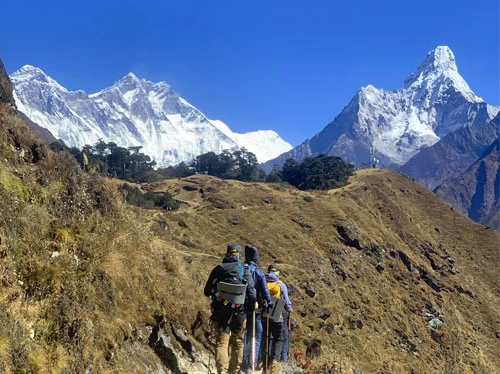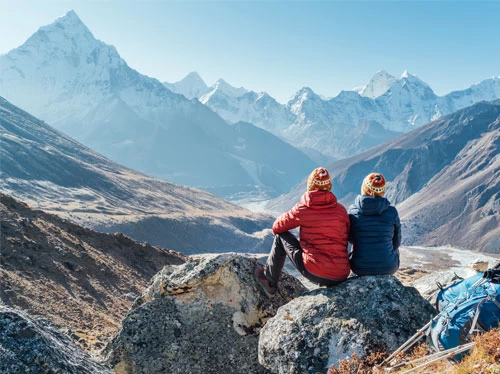Planning to escape to Nepal...if so what about Kalapatthar Trekking 2023-2024 in the Khumbu region of Nepal for the magnificent adventure from Kalapathar (5545M) and Everest Base Camp (5364M)
Khumbu region also popularly known as the Everest region of Nepal is one of the most fascinating and exotic regions for any trekkers into the wild Himalayas of Nepal.
It is a dream destination for many and to experience its reality is only for some. It is so because of its distinct landscape, culture, religion, lifestyle, vegetation, and also the high Himalayas with an altitude of 8848.86 meters.
Khumbu Region is a sub-region of the Solukhumbu district of Nepal, covering an area of 1539.11km² (594.24 sq. mi) bordering the Autonomous region of Tibet. With a long range of Himalayas with hundreds of mountains still to be named, the Khumbu region has everything trekkers or travelers would prefer to explore.
Of the 14 highest mountains in the world, Nepal still holds the record of being blessed with the 8 highest mountains, of which 4 are in the Khumbu region itself.
Thus, making trekkers explore the 4 highest Himalayas which are: Mt. Everest 8848.86 meters is one of the highest existing mountains in the world, Mt. Lhotse 8516 meters holds the record for the 4th highest mountain in the world, Mt. Makalu 8485 meters the 5th highest mountain and Mt. Cho Oyu 8188 meters the 6th highest mountain on the earth.
Apart from above 8000 meters of Himalayas, the Khumbu region has numerous Himalayas still hundreds of them waiting to be named. Some of the popular mountains to be mentioned here are: Nuptse (7861m), Pumori (7161m), Baruntse (7129m), Ama Dablam (6812m), Kangtega (6782m), Cho Polu (6735m), Num Ri ( 6677m), Thamserku (6623m), Taboche (6542m), Cholatse (6440m), Kusum Kanguru (6367m), Imja Tse (6189m), Lobuche (6119m), Kala Patthar (5643m), Gokyo Ri (5357m) are very few to mention.
Khumbu region holds the record for being blessed with multiple trekking trails from Everest Base Camp Trek, Everest Three Pass Trek, Gokyo and Gokyo Ri Trek, Ama Dablam Base Camp Trek, Short Everest View Trek to Expedition and Peak climbing Island Peak Climbing, and Mera Peak Climbing and also a day tour like Everest Base Camp Helicopter Tour.
All these make Khumbu, a region for challenge-taking trekkers, easy hiking trekkers, a short day tour trekkers into the high Himalayas along with low elevation to high, making you choose between your interests. It is a region with high passes, numerous snow-melted lakes, and also a region where Yeti, a mysterious creature dwells.
Khumbu is the only region where the highest number of Sherpa communities dwell, an ethnic group of people living in the high altitudes, making the Namche Bazaar their official headquarters.
Kalapatthar Trekking itinerary 2025-2026 has been designed by Discover Altitude to include all the central highlights of the Khumbu region. Starting the trek from Lukla, which is a short flight from the capital city of Kathmandu, the trail will then take you through the diverse vegetation, flora, and fauna of the Khumbu region.
Crossing the suspension bridge over the Dudh Koshi River, one will enter the Sagarmatha National Conservation Area which is a natural UNESCO World Heritage Site of Nepal.
Further, you ascend towards the headquarters of the Khumbu region which is Namche Bazaar, passing by all the vegetation as you enter the bare Himalayan desert to reach Gorakshep, Everest Base Camp, and finally Kalapatthar.
As Kalapatthar will be the highest altitude of the entire Kalapatthar Trekking 2025-2026 Itinerary, you will visit Everest Base Camp as well, to make your dream destination come true, before descending towards Lukla for your domestic flight to Kathmandu.
Now, the question may arise as to why the Kalapatthar trek. Kalapatthar trek includes two popular viewpoints of the Khumbu/Everest region. They are Everest Base Camp (5,364M) and Kalapatthar (5,545M) together and at the same price, making the trek as Kalapatthar-Everest Base Camp Trek.
Trekkers will not miss the exotic view of the Himalayas existing in the Khumbu region. This will help trekkers to explore the base of the highest mountain Mt. Everest and Kalapatthar for the 360° panoramic view of the Himalayas.
This won’t cost any extra for trekkers neither need to carry any extra equipment nor need to pay for extra accommodation or food as the hike to Kalapatthar is just a 2-3 hours hike from Gorakshep two-way, early in the morning for the sunrise view or sunset view over the Himalayas.
Follow the right trip to explore the majestic view of the entire Khumbu region by choosing Discover Altitude as your travel guide in Nepal.
Highlights of Kalapatthar Trekking
Kalapatthar Trek is one of the fabulous treks into the Khumbu region of Nepal, rich in a diverse culture, religion, and vegetation along with the mighty Himalayas.
Trekking to Kalapatthar will lead you to a region with majestic views of the four highest mountains on earth Mt. Everest (8,848.86M), Mt. Lhotse (8,516M), Mt. Makalu (8,485M) and Mt. Cho Oyu (8,188M).
Further, you can experience a thrilling flight to Lukla from Kathmandu. Kalapatthar Trek will energize any layman with panoramic views of the Himalayas, the vegetation of the Khumbu region, the cultural lifestyle of the Sherpa people and their hospitality, and also the beautiful Monasteries throughout the trail.
One can explore the Tengboche monastery which is the famous monastery of the entire Khumbu region and also the monastery at the highest altitude.
Further, you will be visiting Everest View Hotel in Shyangboche, which holds the Guinness world record of being the highest-placed hotel on earth at an altitude of (3,880M/13,000 ft).
The trail of Kalapatthar Trek will lead you towards the highest overnight camp in Gorekshep (5,140M) before hiking towards Everest Base Camp (5,364M) and our final point and also the highest altitude of the entire Kalapatthar trek is Kalapatthar (5,545) meters.
Kalapatthar trekking is not only a mere trail for the magnificent views of the mighty Himalayas, it is a trail that will lead you through the dense forest towards the bare Himalayas to explore the flora along with fauna at such altitude along with Everest Base Camp.
Further, throughout the Kalapatthar trekking trail, one can feel the true spiritual vibration by visiting numerous monasteries, strolling praying wheels, hanging praying flags, and chanting some religious mantras that will make our materialistic journey flourish.
Kalapatthar Trek Difficulty
The entire Kalapatthar Trekking Trail starts from a moderate to strenuous hike for 11 days, which includes 2 extra nights for acclimatization.
As the trail will lead you toward the most exotic region of the entire Himalayas which is the Khumbu/Everest region. The trail to Everest Base Camp and Kalapatthar will take you through lush green vegetation to the bare Himalayas. This will be at a nominal pace with a smooth climb uphill.
If you are a professional hiker, physically fit, and have been to such high altitudes of over 5,000 Meters before then trekking into Kalapatthar and Everest Base Camp Trek can be accomplished within 9 Days including being at the Base Camp of Everest and Kalapatthar together.
Just feel free to check this link 9 Days Everest Base Camp and Kalapatthar Trek
Food and Accommodation during Kalapatthar Trekking
There are a variety of foods according to the available menu in the Kalapatthar trek with the best possible hotels, lodges, and teahouses. As the altitude increases, the number of hotels decreases but the food remains the same.
Trekkers will find multiple choices of food but all are hygienic, it varies from Continental, Italian, Nepali, Chinese, etc, and even vegetarian and non-vegetarian. But the best choice and suggested and popular food can be ‘Dal Bhat’, which is a typical staple Nepali food.
As the altitude increases from Namche Bazaar, the teahouse for trekkers will be limited. Here trekkers might need to share a room as all the rooms will have two beds for sharing.
Lodges and Tea houses at higher altitudes will be limited. So each room will have two single beds to share with others. This room will have a comfortable bed with a mattress, pillow, blanket, bed sheet, tea table, solar light, etc.
However, toilets and bathrooms will be separated and some lodges will have common toilets on the same floor but some might have them outside the hotel. These toilets are clean and well-maintained.
Best time for Kalapatthar Trekking
Trekking to Kalapatthar or Everest Base Camp is possible throughout the year, however, the best recommended seasons are Autumn and Spring. Autumn mainly is regarded as August-November and Spring from February-May.
This time of the year provides the best temperature, clear blue sky, and visibility with spotless Himalayas views. Along with different vegetation, flora, and fauna, moreover, the trail is clear with less snow to block and there will be regular flights to and from Lukla.
Here, an important point to note is that August the month of Autumn is also a Post-monsoon period and May of Spring is Pre-monsoon. So, if possible try to avoid these two months as well because you will encounter rainfall till Namche Bazaar.
June and July are monsoon seasons, there will be almost rainfall every day. December and January are extreme winters and the possibility of heavy snowfall above Namche Bazaar.
This might create trouble for trekkers and the number of lodges and tea houses will be very limited because heavy snowfall operators of these lodges will descend lower closing all their lodges.
To conclude, the best month for the Kalapatthar trek is without any doubt Spring (February, March, April) and Autumn (September, October, and November).
Equipment for Kalapatthar Trekking
There is no particular equipment for the Kalapatthar trek, as the trail is smooth going but at a high altitude. Trekkers can carry hiking poles, trekking shoes, sleeping bags, and refilling water bottles for this Kalapatthar trek.
You don’t need to carry climbing equipment for the Kalapatthar trek, as the trail is just hiking into the Himalayas.
However, make sure to have warmer clothes in Autumn because Autumn welcomes winter. Have a good sleeping bag, Jacket, hand gloves, sunglasses, suncream, etc., or consult with your agency before you start the trip about the weather conditions.










